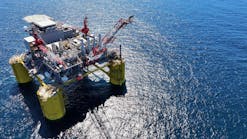Capital constraints likely mean most of the more than 60 refinery projects planned for the Asia Pacific region won't proceed.
That's the consensus among international oil companies and energy consultants that attended a conference on Asian refining in Chiang Mai, Thailand.
Capital requirements for the Asia-Pacific refining projects are estimated at $50 billion, said Bert Lotgering, managing director of Rayong Refinery Co. (RRC), a joint venture of Royal Dutch/Shell Group and Petroleum Authority of Thailand (PTT) that is building a $2.4 billion, 145,000 b/d grassroots refinery at Rayong, Thailand.
Projects covered in the outlook include those under construction, planned, or in various stages of feasibility study. They are intended to reduce the region's worsening shortfall of refining capacity and accommodate the region's 3.5%/year growth in refined products demand.
Meantime, prospects for a sixth refinery in Thailand are slim if the grassroots project is intended only to serve the domestic market.
However, a grassroots refinery project in Thailand could become viable at the turn of the century if it is designed for exports, industry officials say. But it certainly would face fierce competition from Singapore refineries.
In other Southeast Asia refining action, Cambodia plans to revive its only refinery, idled for more than 20 years, with help from foreign companies.
In addition, Petrovietnam senior planners have started drafting plans for Viet Nam's second refinery almost before the ink was dry on an agreement by the state company with Total and Chinese Petroleum Corp. to build the country's first refinery (OGJ, Feb. 14, Newsletter).
CAPITAL CONSTRAINTS
Paul Adair regional manager of energy consultant Saladin Pte., said many Asia Pacific refining projects never will get beyond the discussion stage.
"Apart from anything else, the enormous amount of capital involved will be a significant constraint on new projects," he said. Adair noted the refining industry in the region is competing with many other sectors in the energy industry, including oil exploration and production, natural gas infrastructure development, liquefied natural gas exports/imports, pipelines, terminals, and power generation.
"In fact," Adair said, "the access to capital in many instances will be the determining factor in whether many of these projects get beyond the planning stage.
"There are various issues to take into account, not least the continuing growth of oil consumption, more stringent product quality, and environmental legislation, as well as the structure of oil demand and reliance on imported oil from the Middle East."
Among projects within the Association of Southeast Asian Nations, there are doubts as to whether more than half the planned refining projects will materialize, said Singapore Petroleum Co. Vice Pres. Ong Eng Tong.
Ong said it likely would be more economical to expand and debottle-neck refineries than build a grassroots plant. He estimated the cost of building a grassroots refinery without deep conversion capability at $1 billion and $2 billion for one with deep conversion units.
SINGAPORE REFINERIES
Ong voiced concern over Singapore's position as a regional refining hub if all proposed Asia Pacific refinery projects are realized. He cited Singapore refiners' slump during the mid 1980s when their crude runs collapsed to about 600,000 b/d out of capacity of about 1 million b/d because of reduced demand from Malaysia and Indonesia as a result of those countries' new refineries going on stream.
At first glance, Ong said, Singapore refineries can accommodate regional products needs as a swing supplier to make up any expected shortfall in other countries' refining capacities. However, space limitations in the tiny island republic may constrain expansion plans for Singapore's refineries with a current combined throughput capacity of 1.105 million b/d.
British Petroleum Co. plc's 29,000 b/d refinery may have to be moved in the next few years because its current site will be needed to expand the Port of Singapore, Ong said. And possible expansion of Royal Dutch/Shell's 386,000 b/d refinery on the Singaporean island of Pulau Bukom is limited by lack of space.
While there remains the possibility of additional land reclamation from the sea to increase the size of islands housing other refineries and petrochemical complexes, much of that discussion is focused on higher value added petrochemical industries rather than on new refineries.
However, Ong said, it won't be a great surprise if Singapore refiners Esso, Mobil, and Singapore Refinery Co. each add 100,000 b/d crude distillation units before 2000.
THAI REFINERY
RRC's Lotgering and Piyasvasti Amranand, deputy secretary general of Thailand's National Energy Policy Council, agreed that prospects for a sixth Thai refinery probably are limited to products exports.
Piyasvasti said the expected shortfall in Thailand's refining capacity during 1998 2000 could be met by expansion of refineries now in operation or under construction. With construction under way of two major refineries by RRC and a Caltex Petroleum Corp. group as well as the expansion of Exxon Corp's Sri Racha refinery, Thai refining capacity is expected to reach 770,000 b/d in 1997, achieving products self sufficiency for the kingdom.
The shortfall would materialize by 1998 if the current growth rate of about 10%/year for petroleum products demand continues. Currently, Thai refining capacity of 365,000 b/d meets about 60 70% of domestic products demand.
Lotgering contends any company seeking to establish a Thai refinery geared toward domestic products consumption must be a new entrant to the Thai market that can automatically, capture a substantial market share to be viable.
However, competition in the Thai oil market is very intense, he noted, which makes it extremely difficult for a newcomer to build major market share on a par with the country's four major refiners: Esso, Caltex, Shell, and PTT.
Lotgering, who headed Shell's oil refining operations in Singapore for 5 years, warned that the new refinery must be prepared to face formidable competitors in Singapore that have advantages in terms of a long established base of operations, financial strength, logistics, and location.
"It will be a major undertaking (to challenge Singapore refiners). It is not impossible, but it is not going to be easy," he noted, adding that such a project could be developed in southern Thailand as part of the state backed Southern Seaboard Development plan.
CAMBODIA REFINERY
Phnom Penh regards as a top priority the rehabilitation of the 10,000 b/d refinery built at Kompong Som (Sihanoukville) in 1968 by Ste. Nationale Elf Aquitaine.
The restarted refinery would help meet a severe refined products shortfall in the country and possibly process domestic crude supplies seen prospective off Cambodia.
In an interview with Oil & Gas journal at Chang Mai, Cambodian Minister of Industry, Mines, and Energy Pou Sothirak described the project as the foundation for the country's economic development plans. It also represents the first major project under the government's economic reform program.
All of Cambodia's refined products consumption of about 10,000 b/d is met with imports, mainly from Singapore and Thailand.
Phnom Penh wants the Kompong Som refinery revamp and restart undertaken solely by foreign investors because Cambodia lacks capital, technical knowledge, and managerial skills in running a refinery.
Pou estimated the revamp could cost $50 250 million, depending on the approach used. The proposal has attracted bids by three foreign concerns: Malaysia's Petmal Oil, Japan's Nissho lwai, and most recently a Thai group led by developer Bananchang. In addition, Shell and several Singaporean companies have approached Cambodia with an eye toward participation in the project.
Cambodian official sources said Petmal's proposal calls for a basic revamp, Nisso lwai wants to tear the plant down and build a new one, and the Bananchang group, which includes Chon Buri Muang Thong Co., proposes a combination of the two approaches: revamping some refinery units and replacing others.
While the Thai group's proposal is thought to be favored by Cambodia because of its "realistic nature," Pou emphasized that none of the three bidders has been dropped. "Our decision criteria will be based on trust, confidence, and mutual benefit," he said.
Pou said Cambodia is certain to make a final decision soon on who gets the project license award in order to meet a targeted 1996 start up. Although the refinery restart will be left up largely to foreign investors, the government wants to reserve the right to play a role in any future expansion in the refinery and in disposition of any oil that might be discovered (OGJ, Feb. 21, p. 42).
Pou said it is difficult to predict growth in oil demand in Cambodia but noted the current level of consumption should be regarded as a baseline for future demand projections. Success in attracting foreign investment to Cambodia, under a direct foreign investment policy being drafted, will create economic activity that will significantly increase the country's oil demand, he said.
VIET NAM'S SECOND REFINERY
A second refinery is envisioned for Viet Nam because of expected soaring growth in domestic refined products in consumer and industrial sectors stemming from the rapid transformation of the country's economy.
The proposed second refinery, which may be built along Viet Nam's northern coast, would have a throughput of at least 100,000 b/d. It is tentatively planned to go on stream at the turn of the century, Petrovietnam Refinery, Director Van Tu told OGJ.
Site of the first proposed refinery has shifted from Vung Tau to Khanh Hoa, about 450 km north of Ho Chi Minh City. Tu said the change is in line with Viet Nam's new policy to decentralize development of petroleum related industries away from Vung Tau, which the government wants to develop as a center for a natural gas based industry.
Cost of the second refinery alone, not including substantial costs expected in developing infrastructure and support facilities, is expected to total more than $1 billion.
The first refinery is intended to meet demand in southern Viet Nam and serve as a catalyst for other economic development as well as provide feedstock for a proposed petrochemical complex. The country's second refinery is intended to accomplish the same goals in the north.
The proposed second refinery could go on stream 1 2 years after the first goes on ling in 1998 99. Both would employ advanced technology developed by leading western firms such as UOP, M.W. Kellogg, and Shell, and would process domestic as well as imported crudes.
Viet Nam may decide to export some of its crude oil production, which is high quality and could command premium prices on world markets, and import what it needs for the proposed refineries.
Currently, Viet Nam's total crude production of 130,000 b/d from White Tiger offshore oil field is exported, with about 70% shipped to Japan and 30% to other countries, notably China and Singapore. Much of the country's refined products are supplied by Singapore.
Petrovietnam Chairman Ho Sy Thoang predicts Viet Nam's demand for refined products will jump to about 140,000 160,000 b/d early next century from a little more than 80,000 b/d in 1993. In a low case scenario, the average growth in oil demand is expected to average about 7 8%/year during 1992 2000, Tu said. But he noted it is quite likely growth will be higher, judging from a growth rate of 29% from 1992 levels to about 84,000 b/d in 1993.
Copyright 1994 Oil & Gas Journal. All Rights Reserved.


